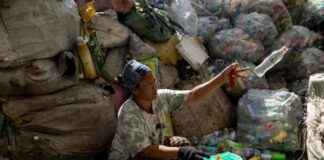Mexico Faces Youth Heatwave Crisis Amid Rising Temperatures
In April of this year, the city of Monterrey in Mexico was hit by a scorching heatwave that left devastation in its wake. María de Jesús Ávila, a sociologist at the Autonomous University of Nuevo León, witnessed a tragic incident during this period. While leaving work, she came across a man lying unconscious on the sidewalk outside a construction site. Despite her efforts to help, it was too late. An ambulance arrived moments later to take his lifeless body away.
This heartbreaking event was just one of many as Mexico grappled with three unprecedented heat waves between April and June 2024. In Monterrey, temperatures soared to a staggering 113°F (45°C), leading to 1,937 heat-related medical cases and 90 fatalities reported by Mexico’s Health Ministry.
The Impact of Climate Change on Young Workers
The recent surge in heat-related deaths among young workers in Mexico has raised alarm bells among scientists and researchers. A study published in the journal Science analyzed heat-related fatalities in Mexico from 1998 to 2019, revealing a troubling trend. Of the 73,000 deaths recorded during this period, a staggering 75 percent occurred among individuals under 35, with children under 5 and adults aged 18–34 being the most vulnerable.
Andrew Wilson, a researcher at Stanford University’s Center on Food Security and the Environment and co-author of the study, emphasized the vulnerability of young adults working outdoors. These individuals, he noted, often lack the awareness and resources to protect themselves from extreme heat, making them more susceptible to heat-related illnesses and fatalities.
The Science Behind Wet-Bulb Temperatures
One of the key factors contributing to the severity of heat-related incidents is wet-bulb temperature, a measure that takes into account both heat and humidity. Unlike conventional temperature readings, wet-bulb temperature provides a more accurate representation of how the human body responds to heat stress.
Wilson explained that high humidity inhibits the body’s ability to cool itself through sweat evaporation, leading to a range of health issues, including death. In regions like Mexico, where wet-bulb temperatures have approached the upper limits of survivability, the risks posed by extreme heat are particularly acute.
The Urgent Need for Climate Adaptation Strategies
As temperatures continue to rise globally, the need for effective climate adaptation strategies to protect vulnerable populations, particularly young workers, has never been more pressing. Tereza Cavazos, a climatologist in Baja California, emphasized the importance of raising awareness among young adults about the dangers of heat exposure in outdoor occupations.
While initiatives like hydration stations in Nuevo León have shown promise in reducing heat-related deaths, targeted actions that prioritize worker protection are essential. Experts like Patrick Behrer of the World Bank underscore the critical role of public policies in safeguarding workers from the adverse effects of rising temperatures.
Looking Ahead: Addressing Climate-Driven Inequality
The findings of the Science study paint a stark picture of the future if current trends persist. Heat-related deaths among individuals under 35 could increase by up to 32 percent by 2100, highlighting the urgent need for proactive measures to mitigate the impact of climate change on vulnerable populations.
As we confront the challenges posed by rising temperatures, it is imperative that we prioritize the safety and well-being of young workers who bear the brunt of climate-driven inequalities. By implementing comprehensive climate adaptation strategies and fostering a culture of awareness and preparedness, we can work towards a future where no life is needlessly lost to extreme heat.
Let’s join hands in supporting initiatives that protect our most vulnerable communities and ensure a sustainable future for generations to come. Together, we can make a difference in the fight against climate change and create a world where all individuals can thrive in a safe and healthy environment.














